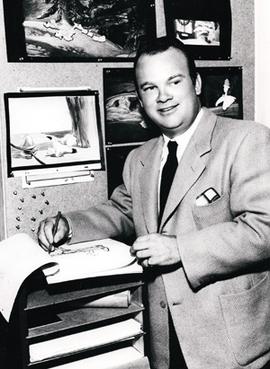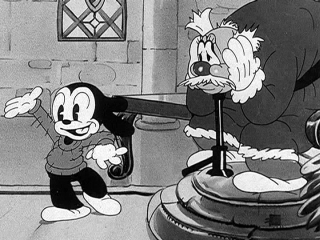Related Research Articles

Frederick Bean "Tex" Avery was an American animator, cartoonist, director, and voice actor. He was known for directing and producing animated cartoons during the golden age of American animation. His most significant work was for the Warner Bros. and Metro-Goldwyn-Mayer studios, where he was crucial in the creation and evolution of famous animated characters such as Bugs Bunny, Daffy Duck, Porky Pig, Elmer Fudd, Droopy, Screwy Squirrel, The Wolf, Red Hot Riding Hood, and George and Junior.
The golden age of American animation was a period in the history of U.S. animation that began with the popularization of sound cartoons in 1928 and gradually ended from 1957 to 1969, where theatrical animated shorts began losing popularity to the newer medium of television animation since in 1957, produced on cheaper budgets and in a more limited animation style by companies such as Terrytoons, UPA, Paramount Cartoon Studios, Jay Ward Productions, Hanna-Barbera, DePatie-Freleng, Rankin/Bass and Filmation. In artefact, the history of animation became very important in the United States.
Hugh Harman and Rudolf Ising were an American animation team and company known for founding the Warner Bros. and Metro-Goldwyn-Mayer animation studios. In 1929, the studio was founded under the name "Harman-Ising Productions", producing Looney Tunes and Merrie Melodies for Leon Schlesinger from 1930 to 1933. From 1934 to 1938, Harman-Ising produced the Happy Harmonies series, with William Hanna as their employee.

Woody Woodpecker is an animated character that appeared in theatrical short films produced by the Walter Lantz Studio and distributed by Universal Pictures between 1940 and 1972.

Walter Benjamin Lantz was an American cartoonist, animator, producer and director best known for founding Walter Lantz Productions and creating Woody Woodpecker.

Bray Productions was a pioneering American animation studio that produced several popular cartoons during the years of World War I and the early interwar era, becoming a springboard for several key animators of the 20th century, including the Fleischer brothers, Walter Lantz, Paul Terry, Shamus Culhane and Grim Natwick among others.
Charles Bear Mintz was an American film producer and distributor who assumed control over Margaret J. Winkler's Winkler Pictures after marrying her in 1924. The couple had two children, Katherine and William. Between 1925 and 1939, Mintz produced over 370 cartoon shorts.
Andy Panda is a cartoon character who starred in his own series of animated cartoon short subjects produced by Walter Lantz. These "cartunes" were released by Universal Pictures from 1939 to 1947, and United Artists from 1948 to 1949. The title character is an anthropomorphic cartoon character, a cute panda. Andy became the second star of the Walter Lantz cartoons after Oswald the Lucky Rabbit. He achieved considerable popularity until being eventually supplanted by Woody Woodpecker.
Color Rhapsody is a series of usually one-shot animated cartoon shorts produced by Charles Mintz's studio Screen Gems for Columbia Pictures. They were launched in 1934, following the phenomenal success of Walt Disney's Technicolor Silly Symphonies and Warner Bros.' Merrie Melodies. Because of Disney's exclusive rights to the full three strip Technicolor process, Color Rhapsody were produced in the older two-tone Technicolor process until 1935, when Disney's exclusive contract expired.

Academy Award Review of Walt Disney Cartoons is a 1937 American animated package film released in the United States on May 19, 1937, for a limited time to help promote the upcoming release of Snow White and the Seven Dwarfs. It was a collection of five Oscar-winning Silly Symphonies shorts, bridged together with title cards and a narrator. Like The Many Adventures of Winnie the Pooh, each of the cartoons had been released on their own at first before being collected together as one film. The separate cartoon shorts are now available on DVD. In addition, the film is 41 minutes long, just like Saludos Amigos. However, while this film is fully animated, Saludos Amigos would be far shorter without the live-action sequences. It is considered the first film in the Walt Disney Pictures filmography.
This is a list of animated cartoons that star Woody Woodpecker, who appeared in 203 cartoons during and after the Golden age of American animation. All the cartoons were produced by Walter Lantz Productions, and were distributed by Universal Pictures, United Artists and Universal International. Also listed are miscellaneous cartoons that feature Woody but are not a part of the main short series.
Holiday for Shoestrings is a 1946 Warner Bros. Merrie Melodies cartoon short directed by Friz Freleng. The short was released on February 23, 1946. The film is a spoof of the fairy tale "The Elves and the Shoemaker".
Wet Blanket Policy is the 30th animated cartoon short subject in the Woody Woodpecker series. Released theatrically on August 27, 1948, the film was produced by Walter Lantz Productions and distributed by United Artists. The film would later be reissued by Universal Pictures, Lantz's former distributor. The title is a play-on-words about a type of insurance policy.
The Dizzy Acrobat is the eighth animated cartoon short subject in the Woody Woodpecker series. Released theatrically on May 21, 1943, the film was produced by Walter Lantz Productions and distributed by Universal Pictures.
Confidence is a 1933 Pre-Code animated short subject, produced by Walter Lantz, directed by Bill Nolan, and featuring Oswald the Lucky Rabbit. In the film, Oswald was voiced by multiple actors in this short. Oswald is a farmer whose farm falls prey to the ominous influence of the Great Depression. Determined to find a solution, Oswald flies to Washington, D.C. where he meets President Franklin D. Roosevelt. It was released by Universal Pictures on July 31, 1933 and is available on The Woody Woodpecker and Friends Classic Cartoon Collection DVD box set.

Richie Rich is a 1996 animated television series produced by Harvey Films and Film Roman and distributed by Claster Television. It is based on the Harvey Comics character of the same name. It aired for one season, and also includes select Harveytoons shorts. Unlike the Hanna-Barbera version which depicted a somewhat older Richie closer to adolescence, this revival series was more faithful to the comics, as Richie Rich appeared in his original form as a younger child in his tuxedo and shorts.
Not So Quiet is a 1930 animated short film produced by Walter Lantz and stars Oswald the Lucky Rabbit. The title is a parody of All Quiet on the Western Front, an Academy Award-winning Universal film released in the same year.

The Merry Old Soul is a 1933 animated short film by Walter Lantz Productions, as part of the Oswald the Lucky Rabbit series. The cartoon was nominated for an Academy Award.
Musical Moments from Chopin is a 1947 Musical Miniatures cartoon, co-starring Andy Panda and Woody Woodpecker. It was directed by Dick Lundy and was released on February 24, 1947.

Swing Symphony is an American animated musical short film series produced by Walter Lantz Productions from 1941 to 1945. The shorts were a more contemporary pastiche on Walt Disney's Silly Symphonies, and often featured top boogie-woogie musicians of the era. While the first cartoon include the characters Woody Woodpecker and Andy Panda, it mainly features a variety of different characters created exclusively for the series, with Oswald the Lucky Rabbit making an appearance in one cartoon.
References
- ↑ FilmAffinity
- ↑ Lenburg, Jeff (1999). The Encyclopedia of Animated Cartoons. Checkmark Books. p. 154. ISBN 0-8160-3831-7.
- ↑ "The 7th Academy Awards (1935) Nominees and Winners". oscars.org. Retrieved March 28, 2014.
- ↑ Crump, William D. (2019). Happy Holidays—Animated! A Worldwide Encyclopedia of Christmas, Hanukkah, Kwanzaa and New Year's Cartoons on Television and Film. McFarland & Co. p. 156. ISBN 9781476672939.
- ↑ Nitrate Shorts I-George Eastman Museum